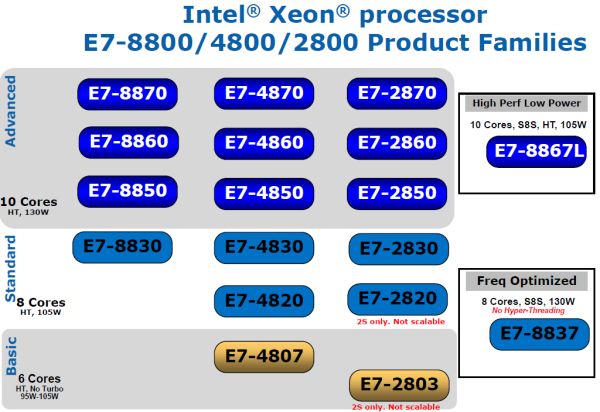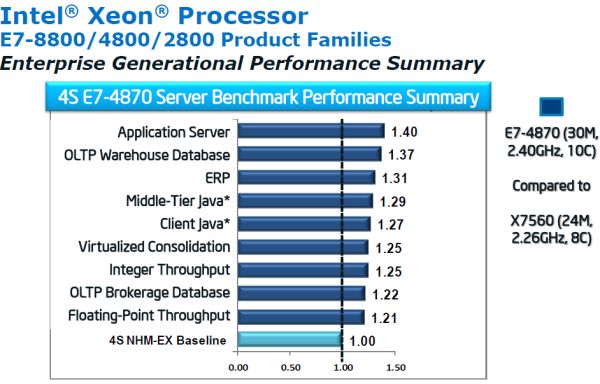Westmere-EX: Intel Improves their Xeon Flagship
by Johan De Gelas on April 6, 2011 2:39 PM EST- Posted in
- IT Computing
- Intel
- Nehalem EX
- Xeon
- Cloud Computing
- Westmere-EX
Westmere-EX SKUs and Performance
Intel has three general classifications for the new 10-core processors. The E7-x870 runs at 2.4GHz and has a 30MB L3, while the E7-x860 runs at 2.26GHz and the E7-x850 runs at 2.13GHz; the lower clocked models are also downgraded to a 24MB L3. As there are versions for 8-, 4-, and 2-socket servers, we get nine new SKUs. Pricing on the highest end 8-socket models is very high, but that's not too surprising for the target market: the E7-8870 costs $4616, the E7-8860 goes for $4061, and the E7-8850 comes with a "bargain" price of $3059. For quad-socket chips, you can knock that down about $225, and dual-socket chips will reduce prices another $175 or so.
What this means is pricing for the fastest Xeons has increased by about $1000, a clear sign that Intel does not expect any competition in the small but profitable high-end x86 market. And indeed, the current AMD "Magny-cours" is targeted at the midrange server market, not the high-end. Bulldozer will be AMD's attempt to take on these new Xeon models, and it probably won't attack this high-end market before the end of the year.
Also present is a low power E7-8867L, which runs 10 cores at 2.13GHz but needs 105W instead of the 130W of the E7-8850. For the 25W drop in TDP, the price jumps up to $4172.
The E7-8837 is another interestin processor. It has eight cores and forgoes Hyper-Threading, so it's like the Nehalem-EX but with a 2.67GHz clock it runs 18% higher than the fastest Nehalem-EX CPUs. Thus, it looks like the 45nm to 32nm transition either delivers two extra cores and a 6% clockspeed increase, or it improves clocks by 18% with the same number of cores. Below is the complete table of new SKUs.
| Intel Xeon Westmere Specifications and Features | ||||||
| Processor Number | Frequency | L3 Cache | Cores / Threads | Turbo / HTT | TDP | 1kU Pricing |
| Xeon E7-8870 | 2.4GHz | 30MB | 10 / 20 | Yes / Yes | 130W | $4,616 |
| Xeon E7-8860 | 2.26GHz | 24MB | 10 / 20 | Yes / Yes | 130W | $4,061 |
| Xeon E7-8850 | 2.00GHz | 24MB | 10 / 20 | Yes / Yes | 130W | $3,059 |
| Xeon E7-8830 | 2.13GHz | 24MB | 8 / 16 | Yes / Yes | 105W | $2,280 |
| Xeon E7-8867L | 2.13GHz | 30MB | 10 / 20 | Yes / Yes | 105W | $4,172 |
| Xeon E7-8837 | 2.67GHz | 24MB | 8 / 8 | Yes / No | 130W | $2,280 |
| Xeon E7-4870 | 2.40GHz | 30MB | 10 / 20 | Yes / Yes | 130W | $4,394 |
| Xeon E7-4860 | 2.26GHz | 24MB | 10 / 20 | Yes / Yes | 130W | $3,838 |
| Xeon E7-4850 | 2.00GHz | 24MB | 10 / 20 | Yes / Yes | 130W | $2,837 |
| Xeon E7-4830 | 2.13GHz | 24MB | 8 / 16 | Yes / Yes | 105W | $2,059 |
| Xeon E7-4820 | 2.00GHz | 18MB | 8 / 16 | Yes / Yes | 105W | $1,446 |
| Xeon E7-4807 | 1.86GHz | 18MB | 6 / 12 | No / Yes | 95W | $890 |
| Xeon E7-2870 | 2.40GHz | 30MB | 10 / 20 | Yes / Yes | 130W | $4,227 |
| Xeon E7-2860 | 2.26GHz | 24MB | 10 / 20 | Yes / Yes | 130W | $3,670 |
| Xeon E7-2850 | 2.00GHz | 24MB | 10 / 20 | Yes / Yes | 130W | $2,558 |
| Xeon E7-2830 | 2.13GHz | 24MB | 8 / 16 | Yes / Yes | 105W | $1,779 |
| Xeon E7-2820 | 2.00GHz | 18MB | 8 / 16 | Yes / Yes | 105W | $1,334 |
| Xeon E7-2803 | 1.73GHz | 18MB | 6 / 12 | No / Yes | 105W | $774 |
| Xeon E3-1280 | 3.50GHz | 8MB | 4 / 8 | Yes / Yes | 95W | $612 |
| Xeon E3-1275 | 3.40GHz | 8MB | 4 / 8 | Yes / Yes | 95W | $339 |
| Xeon E3-1270 | 3.40GHz | 8MB | 4 / 8 | Yes / Yes | 80W | $328 |
| Xeon E3-1260L | 2.40GHz | 8MB | 4 / 8 | Yes / Yes | 45W | $294 |
| Xeon E3-1245 | 3.30GHz | 8MB | 4 / 8 | Yes / Yes | 95W | $262 |
| Xeon E3-1240 | 3.30GHz | 8MB | 4 / 8 | Yes / Yes | 80W | $250 |
| Xeon E3-1235 | 3.20GHz | 8MB | 4 / 8 | Yes / Yes | 95W | $240 |
| Xeon E3-1230 | 3.20GHz | 8MB | 4 / 8 | Yes / Yes | 80W | $215 |
| Xeon E3-1220L | 2.20GHz | 3MB | 2 / 4 | Yes / Yes | 20W | $189 |
| Xeon E3-1225 | 3.10GHz | 6MB | 4 / 8 | Yes / Yes | 95W | $194 |
| Xeon E3-1220 | 3.10GHz | 8MB | 4 / 8 | Yes / Yes | 80W | $189 |
Taken together, the two extra cores (up to 25% more performance) and a 6% clock increase, along with some subtle core improvements, mean the Westmere-EX parts should deliver 20-40% more performance within the same TDP. It's not enough to revolutionize the server space, but more performance per watt is nothing to sneeze at.












32 Comments
View All Comments
JohanAnandtech - Thursday, April 7, 2011 - link
Correct. the Octal CPU market is shrinking fast now that we have 10 and 12 core machines. VMware only recently update vSphere to be able to work with 160 logical CPUs. Linux is able to go up to 255 logical CPUs I believe (x86-64).jihadjoe - Wednesday, April 6, 2011 - link
Rack space can get expensive pretty quickly. When you're renting out space per-rack at a colocation facility, you want to consolidate as much as possible.Power efficiency is another. More cpus per server mean less supporting hardware. Imagine virtualizing 200 or so Atoms with a single 4x 10-core Xeon setup. Atom may well be efficient, but getting rid of 200 chipsets, LAN adapters and GPUs will save quite a bit of energy.
mozartrules - Wednesday, April 6, 2011 - link
Big companies try to run virtualized environments (think VMWare) where many applications run on the same server. Different applications tend to use CPU at different times so end up with much higher average usage of your hardware. My employer (a huge bank) often expect a 4-10 times benefit from running on servers that are bigger than this. It also simplifies administration.The purchase cost of these servers are often a relatively small part of the actual cost. Rack space, power, heat, administration and network connectivity are important considerations. And the RAM cost will often exceed the CPU cost.
I happen to work on an application that needs all data in memory (huge Monte-Carlo model), even a microsecond latency for accessing data would kill performance. This means that I run on a 32-core Nehalem EX with 512Gb RAM and I use all of it. The 512Gb RAM is about 2/3rds of the whole server, partly because it is a lot of RAM and partly because 16Gb DIMMs are a lot more expensive per Gb that desktop memory.
Calin - Thursday, April 7, 2011 - link
There are two reasons:1. Workloads that scale poorly on more systems. If your workload scales perfectly, you can get faster results cheaper by going with more and somewhat slower processors.
2. When your workload will work on a (let's say) 4-processor system with the faster processors, but only on a 8-processor system using the slow processors. In this case, a base 4-processors system with expensive processors might be cheaper than an 8-processors system with cheap processors and offer similar or better performance.
That is, some workloads scale perfectly well over more servers, others scale perfectly well over more processors, and others don't scale well enough over more servers/processors. If your workload is the latter, you want the fastest processors around.
And by the way, some things are really really influenced by performance (see stock market manipulation games when you being half a millisecond faster than the competition means you can earn more money). In the grand scheme of things, the hardware price might be a small consideration (or might be the driving factor). If you absolutely need that performance (and can gain financial use from it), those processors are cheap at whatever price.
alent1234 - Thursday, April 7, 2011 - link
virtualization and huge databasesfor VM this monster will replace a lot of servers, probably a hundred or more. depending on your version of vmware. i think the later versions will let you oversubscribe a host
if you have a database server that hosts tens of thousands of users at a time than going from 2 6 core CPU to 4 10 core CPU's means 24 threads vs 80 threads at a time can be processed.
hellcats - Thursday, April 7, 2011 - link
Can I have that bad boy when you're done testing?MrBuffet - Thursday, April 7, 2011 - link
Especially if you are counting on getting benchmarks that includes Windows 2008 R2 -- as you can see here http://support.microsoft.com/kb/2529956/us-en -- Intel and Microsoft apparently forgot to cross-test their products.While both are clearly at blame here, this is a MAJOR black eye to the Intel validation department, I mean how can you realease a new processor that do not work with the most sold OS in the world...embarrasing to say the least, and makes you wonder what else they missed
alent1234 - Thursday, April 7, 2011 - link
that's assuming you use WIndows 2008 R2 as your hypervisor. most people use vmware.JohanAnandtech - Thursday, April 7, 2011 - link
Thx! Excellent feedback, will save us quite a bit of time and searching. We will talk this through with both MS and Intel.koinkoin - Thursday, April 7, 2011 - link
Well, some of the customers I work with have some very specific work load. They do research and development and for them it is worth to have the best performance when they buy the system…About price, yes and no, as with 64 memory slot you can get a good price per gigabit compared to a system with only 18 slots or so if you need around 256GB or more memory. So there it can be good, but again specific.
But you are right, for most Virtualization system I would rather go with 2U system like the Dell R710 who fit a good balance of CPU power and memory options at a better price. You can have them redundant so you can lose one or more to distribute your loads.